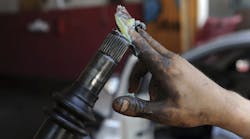The National Institute of Standards and Technology (NIST) – one of the nation’s oldest physical science laboratories – defines lubrication as any means capable of controlling friction and wear of interacting surfaces in relative motion under load.
Typically, lubricants are liquids or semi-liquids, but may be solids or gases or any combination thereof. Lubricants can be divided into four basic classes.
- Oils – A general term used to cover all liquid lubricants.
- Greases – Normally these are oils which contain a thickening agent to make them semi-solid.
- Dry lubricants – Any lubricant that is in solid form.
- Gases – The gas most commonly employed is air.
Lubrication, regardless of type, focuses on the same key principle: building an oil film between two mating surfaces that move relative to each other to separate the surfaces and prevent them from touching, say officials with Mobil Industrial Lubricants (www.mobilindustrial.com), which offer performance lubricant and specialty products and services. Achieving this goal reduces friction and can help prevent wear caused by direct surface-to-surface contacts.
What’s more, reducing friction in vehicles and equipment reduces the consumption of energy for the same amount of work delivered.
THE THICKENER MATRIX
“While the lubrication principles for oils and greases are the same, the fundamental difference between the two is the method by which the oil is supplied to the contact zone,” explain the Mobil officials. “Lube oils of 10 ten require complex ancillary support equipment to condition and deliver the oil to the contact zone, prevent leakage and minimize contamination ingress.
“In contrast, lubricating grease delivers the oil via the thickener matrix. This matrix serves as a reservoir of lubricating oil for future use, as well as a method to keep the oil in place in application.”
The officials say a good way to think of grease is to consider it as a sponge (thickener matrix) soaked in oil.
“Under no-stress conditions, the sponge holds the oil within its matrix, ready to be released to provide lubrication. When stressed in application (e.g., rotation, churning, temperature, etc.), the sponge releases the oil to provide the necessary oil film.”
Along with providing lubrication, the officials add that “grease also serves as a seal preventing environmental ingress that can lead to premature failure of the grease and the lubricated equipment.”




